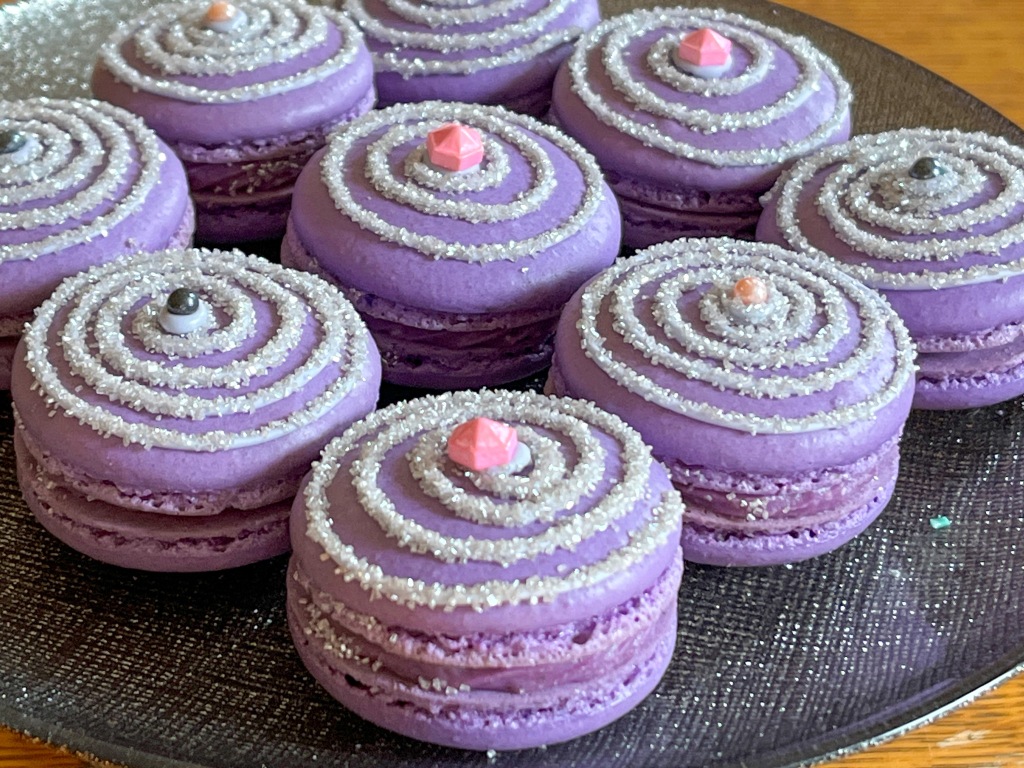Back in December last year I had a lot of fun playing with ube, the Filipino ingredient that was new to me. Today I share two ways to make sourdough bread incorporating ube. The basic recipe is the same, but in the first version I substituted some of the flour with ube powder. The second version incorporates 1/4 tsp ube extract in the dough. The one with the ube powder got a super light purple tone and the texture and structure of the bread was slightly different from a regular sourdough. If you are looking for color impact, definitely go with ube extract. A little goes a long way, and the taste is very mild.
UBE SOURDOUGH – VERSION #1
UBE SOURDOUGH, TWO WAYS
(from the Bewitching Kitchen)
480g white bread flour
20g ube powder
10g salt
350g water
75-90g sourdough starter at 100% hydration
Make the levain mixture about 6 hours before you plan to mix the dough. It should be very bubbly and active.
When you are ready to make the final dough, place the water in the bowl of a KitchenAid type mixer and dissolve the starter in it, mixing with a spatula briefly, then add the flour, ,ube powder and salt. Turn the mixer on with the hook attachment and knead the dough for 4 minutes at low-speed all the time. You will notice the dough will gain quite a bit of structure even with just 4 minutes in the mixer. Remove from the machine, and transfer to a container lightly coated with oil, cover lightly with plastic wrap and allow it to ferment for 4 hours, folding every 45 minutes or so. Because the dough is already a bit developed from the initial time in the mixer, you should get very good structure after 3 and a half hours, or even sooner than that.
After four hours bulk fermentation, shape the dough as a ball, and place, seam side up, in a lightly floured banetton. Leave at room temperature one hour, and then place in the fridge overnight, from 8 to 12 hours.
Next morning, heat the oven to 450F.
Place a parchment paper on top of the dough, a flat baking sheet, and invert the dough, flipping it out of the banneton. Flour the surface of the dough, add the stencil and air-brush if so desired. Score with a razor blade.
Bake at 450F for 45 minutes, preferably covered for the first 30 minutes to retain steam. Cool completely over a rack before slicing.
FOR VERSION #2
Use 500g bread flour and add 1/4 tsp ube extract to the dough, following the same method to prepare and bake the bread.
ENJOY!
to print the recipe, click here
Comments: You will notice that the crumb is tighter than usual for a sourdough, and also the color purple is super subtle, quite light. Version #2, with ube extract got a lot more color.
UBE SOURDOUGH – VERSION #2
I used a different method to decorate it, with oats to form little flowers and black sesame seeds in the center. Just wet the surface of the dough a little bit and that acts like a glue.
It was a bit time-consuming to do, so I ended up forming just 4 little flowers. Maybe next time I can go for full-coverage…
The crumb was open and super purple!
So, if you like to play with this ingredient, I would recommend the extract, because I felt the dough was quite affected in its structure when some of the flour (therefore gluten) was removed and replaced with the powder. Also, the color that the extract provides is quite spectacular and stayed unchanged with baking. Flavor is very subtle.
ONE YEAR AGO: Brown Butter Dulce de Leche Cookie Cups
TWO YEARS AGO: Chicken Poblano Tortilla Soup
THREE YEARS AGO: Kung Pao Chicken
FOUR YEARS AGO: Galette de Rois
FIVE YEARS AGO: Sous-Vide Overnight Oatmeal
SIX YEARS AGO: A Valentine’s Day Opera
SEVEN YEARS AGO: Incredibly Simple Times Four
EIGHT YEARS AGO: Walnut-Cranberry Sourdough Bread
NINE YEARS AGO: Ottolenghi in Brazil?
TEN YEARS AGO: Roasted Winter Vegetables with Miso-Lime Dressing
ELEVEN YEARS AGO: 2012 Fitness Report: P90X2
TWELVE YEARS AGO: Caramelized Bananas
THIRTEEN YEARS AGO: Roasted Lemon Vinaigrette
FOURTEEN YEARS AGO: Whole Wheat Bread















